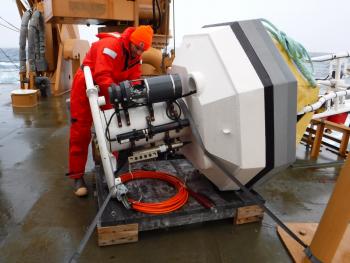Shrinking Sensors for Arctic Research
Miniaturizing nutrient sensors for research platforms
The problem with this approach (taking in situ measurements) has always been that chemical analysers require a lot of power and consume large amounts of liquid chemical reagents. This means that they tend to be large, bulky, and limited in how many measurements they can perform. At NOC, we wanted to use new technologies to make chemical nutrient analysers smaller and more efficient in terms of power and fluid consumption, and this is what led us to the world of microfluidics.
Microfluidics (sometimes referred to as lab-on-chip technology) involves manipulating very small amounts of fluid using tiny fluidic channels and miniaturized valves and pumps. The fluidic channels in our lab-on-chip sensors are just 150 micro-meters wide (a typical size for a human hair), and each measurement requires just 250 micro-litres (one quarter of a millilitre) of seawater. The research field of microfluidics has traditionally found most of its applications in the biomedical sciences (aiming to miniaturize and speed-up medical tests, for example), but we were one of the first groups to apply this technology to the environmental sciences.
Using microfluidics means we really cut down on the amount of fluid used by the analysers (both in terms of liquid reagent and seawater sample required), and on the power consumed (it takes less energy to pump smaller volumes of fluid). This means that we can deploy the analyzers for longer time periods in remote locations and obtain long time series measurements. Another advantage of microfluidics is that the equipment generally tends to be smaller, meaning that we can deploy the analyzers in situations where space is limited, such as on autonomous underwater vehicles or ocean gliders.
At NOC Southampton we have been developing miniaturised chemical analyzers using lab-on-chip technology since about 2007, although in the last couple of years we have made significant gains in terms of reliability and performance. Just this year we have deployed LOC sensors in rivers, estuaries, on the seafloor, in glacial meltwater streams, in the Arctic Ocean (Fram straight), as well as on the ITAE buoy in the Arctic.
The LOC system that we have deployed on the ITAE buoy measures nitrate, although we are also developing LOC sensors to measure phosphate, silicate, dissolved iron and pH. An understanding of all of these parameters is often essential in order to assess the state of the ocean ecosystem and understand the underlying chemical and biological processes. We engineered our LOC systems so that they are all based on the same common platform, so that, apart from a slightly different chemical method, there are very few differences between each of the sensors. This really helps when scaling up production, and also when developing a LOC sensor for a new parameter. In future we hope to expand our range of parameters by developing sensors for, among other things, dissolved inorganic carbon (DIC), total alkalinity and organic nutrients.
Just this year we have deployed LOC sensors in rivers, estuaries, on the seafloor, in glacial meltwater streams, as well as on the ITAE buoy in the US Arctic. - Alex Beaton
Producing microfluidic systems capable of being deployed in the ocean requires specialist manufacturing facilities and techniques that we have developed in house. The “chip” part of lab-on-chip refers to the plastic substrate that contains the microfluidic channels. We have specialist micro-mills that can precisely cut these channels and features, and specially developed bonding techniques for sealing the microfluidic channels once they have been cut. We are often asked why, if the channels are so small, they don’t get blocked by particles in the seawater. We place a filter on the inlet of the sensor that blocks anything larger than 0.45 micro-meters from entering the channels. Because the analysers only suck in small amounts of fluid, the filter lasts quite a long time before it itself becomes completely blocked.
In the last year we have produced over 30 copies of our LOC nitrate sensor, each with its own serial number, and these have been deployed in various locations around the world. We are excited to be part of the ITAE project, and hope to work together again in future to combine more of our innovative technologies to advance the exploration of science the Arctic.

